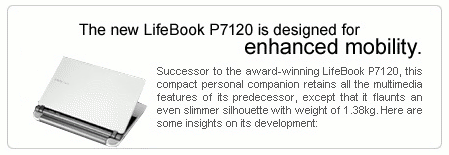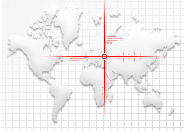Archived content
NOTE: this is an archived page and the content is likely to be out of date.
LifeBook P7120: Developers' Stories (Vol. 2)


Vol. 1 |
Vol. 2Challenge: Compact Shape and Fan-less Structure |
Vol. 3 |
Vol. 4 |
 Katsumi Tokuhashi, Procurement Control Department (left), Eiichi Mori, LCD Planning Department (right)
Katsumi Tokuhashi, Procurement Control Department (left), Eiichi Mori, LCD Planning Department (right)
Q.1) What is the LED backlight LCD used on LifeBook P7120?
|
Mori: |
This LCD adopts a white LED* backlight instead of CCFL* that has been used for a long time. Our LED, which has been greatly improved in light emission efficiency, is a very advanced device as a light source. For this model, a new technology of LED backlight is used and, at the same time, surface brightness equivalent to or more than the previous models is attained. *White LED is a LED that emits single white coloured light. *CCFL is an abbreviation for "Cold Cathode Fluorescent Lamp" used for the light source of the LCD, which uses just as a small fluorescent lamp. |
Q.2) Recently, LEDs are used for many things, such as traffic lights and flashlights. Is the LED backlight for this model the same as those used for large-type LCD TVs?
|
Tokuhashi: |
TV LCDs use RGB* LED backlight. This is different from white LED backlight used for LifeBook P7120. *RGB LED backlight is a type of LED which emits red (R), green (G) and blue (B) light. White is a result of mixing these three colours. |
Q.3) How is white LED backlight different from RGB LED backlight?
|
Mori: |
RGB LED backlight works by combining red, green, and blue-colored LED, while white LED backlight uses only white LED. Mounting space can thus be made smaller compared to RGB LED and the backlight itself becomes smaller. |
Q.4) So, white LED backlight is ideal for LCD on compact PCs.
|
Mori: |
The LED adopted for the new LifeBook P7120 was developed in collaboration with Japan's top LCD manufacturer. During development, there was suggestion to use a white LED, but we were not totally confident because the conventional white LED has a lower light emission efficiency compared to CCFL, and it has been used only for small devices such as mobile phones. However, the LCD panel can be made thinner and lighter using LED backlight because the light guide plate to diffuse the backlight on the whole LCD can be thinner, and inverted circuitry to light up CCFL is unnecessary if LED backlight is used. I strongly wanted to incorporate at least a white LED backlight for enhancement of mobility. |
Q.5) I know some other notebook PCs also incorporate LED backlight LCD.
|
Tokuhashi: |
In fact, there are some notebook PCs using white LED backlight, but none of them has a display as big as 10.6 inch wide. Besides that, the white LED adopted for the backlight for LifeBook P7120 is the latest one and light emission efficiency is greatly different from other LEDs. |
Q.6) You mean it is hard to make a large size white LED backlight LCD panel?
|
Tokuhashi: |
Yes. Besides light emission efficiency, brightness easily becomes uneven as the display size gets larger because LED is a dot light source. To improve display quality, we went through a very hard time. In modifying the design of the light guide plate, we had repeated discussions and deliberation with the LCD manufacturer until the brightness became even. We worked very hard and nearly missed the deadline before we were finally successful. The final completed LCD was very bright and clear. We were very satisfied to see such crystal clear images on the display. |
Q.7) You said the latest white LED was incorporated into this model. Does this mean that the LCD panel was developed in a very short period?
|
Tokuhashi: |
Yes, the LCD panel was developed in a short period, but the development never ran smoothly. All of us knew and persisted that the white LED backlight is absolutely essential for the new LifeBook P7120. Success in development of the LCD panel using a modified new white LED was thanks to that persistence. |
Q.8) Lastly, please tell us the sales point of the LCD of LifeBook P7120.
|
Tokuhashi: |
The LCD of LifeBook P7120 is bright and designed to be suitable to play DVDs, movies, etc. Compared to other notebook PCs, dark or dim moody scenes can be played clearly and beautifully on the LifeBook P7120. |
|
Mori: |
Please check out its slim shape, too! |


